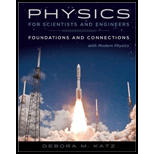
Concept explainers
To allow a car to slow down or stop, hydraulic brakes transmit forces from a master cylinder to the brake pads through a fluid. Imagine this system as a tube filled with an incompressible fluid and a piston on each end. A force of 95.0 N is applied to a piston 2.65 cm in diameter on one end of the tube. a. What is the magnitude of the force that is exerted on the piston 5.15 cm in diameter on the other side? b. If the 2.65-cm piston is displaced by 1.00 cm, by how much is the 5.15-cm piston displaced?
(a)
Magnitude of force that is exerted on the piston on the other side.
Answer to Problem 40PQ
The magnitude of the force exerted on the piston on the other side is
Explanation of Solution
Pascal’s law states that pressure applied to a point of the fluid is transmitted equally and undiminished throughout the fluid. Therefore the pressure at either ends of the piston is equal.
Here,
Write the equation to find
Here,
Write the equation to find
Here,
Equate equations (I) and (II) and solve for
Write the equation to find the area of cross-section of end 1.
Here,
Write the equation to find the cross- section of end 2.
Here,
Write the equation to find
Here,
Write the equation to find
Here,
Conclusion:
Substitute
Substitute
Substitute
Therefore, the magnitude of the force exerted on the piston on the other side is
(b)
Displacement of
Answer to Problem 40PQ
The
Explanation of Solution
The fluid used in the brakes of automobiles are incompressible. So the volume of fluid displaced by the first piston must be equal to the volume of fluid displaced by second piston.
Here,
Write the equation to find
Here,
Write the equation to find
Here,
Substitute equations (VIII) and (IX) in above equation and solve for
Conclusion:
Substitute
Substitute
Substitute
Therefore, the
Want to see more full solutions like this?
Chapter 15 Solutions
Physics For Scientists And Engineers: Foundations And Connections, Extended Version With Modern Physics
- The figure shows the velocity versus time graph for a car driving on a straight road. Which of the following best describes the acceleration of the car? v (m/s) t(s) The acceleration of the car is negative and decreasing. The acceleration of the car is constant. The acceleration of the car is positive and increasing. The acceleration of the car is positive and decreasing. The acceleration of the car is negative and increasing.arrow_forwardWhich figure could represent the velocity versus time graph of a motorcycle whose speed is increasing? v (m/s) v (m/s) t(s) t(s)arrow_forwardUnlike speed, velocity is a the statement? Poisition. Direction. Vector. Scalar. quantity. Which one of the following completesarrow_forward
- No chatgpt pls will upvote Already got wrong chatgpt answerarrow_forward3.63 • Leaping the River II. A physics professor did daredevil stunts in his spare time. His last stunt was an attempt to jump across a river on a motorcycle (Fig. P3.63). The takeoff ramp was inclined at 53.0°, the river was 40.0 m wide, and the far bank was 15.0 m lower than the top of the ramp. The river itself was 100 m below the ramp. Ignore air resistance. (a) What should his speed have been at the top of the ramp to have just made it to the edge of the far bank? (b) If his speed was only half the value found in part (a), where did he land? Figure P3.63 53.0° 100 m 40.0 m→ 15.0 marrow_forwardPlease solve and answer the question correctly please. Thank you!!arrow_forward
- You throw a small rock straight up from the edge of a highway bridge that crosses a river. The rock passes you on its way down, 5.00 s after it was thrown. What is the speed of the rock just before it reaches the water 25.0 m below the point where the rock left your hand? Ignore air resistance.arrow_forwardHelp me make a visualize experimental setup using a word document. For the theory below.arrow_forwardHow to solve this, given answerarrow_forward
- Three point-like charges are placed at the corners of a square as shown in the figure, 28.0 cm on each side. Find the minimum amount of work required by an external force to move the charge q1 to infinity. Let q1=-2.10 μC, q2=+2.40 μС, q3=+3.60 μC.arrow_forwardA point charge of -4.00 nC is at the origin, and a second point charge of 6.00 nC is on the x axis at x= 0.820 mm . Find the magnitude and direction of the electric field at each of the following points on the x axis. x2 = 19.0 cmarrow_forwardFour point-like charges are placed as shown in the figure, three of them are at the corners and one at the center of a square, 36.0 cm on each side. What is the electric potential at the empty corner? Let q1=q3=+26.0 µС, q2=-28.0 μC, and q4=-48.0μc Varrow_forward
 Principles of Physics: A Calculus-Based TextPhysicsISBN:9781133104261Author:Raymond A. Serway, John W. JewettPublisher:Cengage Learning
Principles of Physics: A Calculus-Based TextPhysicsISBN:9781133104261Author:Raymond A. Serway, John W. JewettPublisher:Cengage Learning Physics for Scientists and Engineers: Foundations...PhysicsISBN:9781133939146Author:Katz, Debora M.Publisher:Cengage Learning
Physics for Scientists and Engineers: Foundations...PhysicsISBN:9781133939146Author:Katz, Debora M.Publisher:Cengage Learning College PhysicsPhysicsISBN:9781938168000Author:Paul Peter Urone, Roger HinrichsPublisher:OpenStax College
College PhysicsPhysicsISBN:9781938168000Author:Paul Peter Urone, Roger HinrichsPublisher:OpenStax College
 College PhysicsPhysicsISBN:9781285737027Author:Raymond A. Serway, Chris VuillePublisher:Cengage Learning
College PhysicsPhysicsISBN:9781285737027Author:Raymond A. Serway, Chris VuillePublisher:Cengage Learning College PhysicsPhysicsISBN:9781305952300Author:Raymond A. Serway, Chris VuillePublisher:Cengage Learning
College PhysicsPhysicsISBN:9781305952300Author:Raymond A. Serway, Chris VuillePublisher:Cengage Learning





